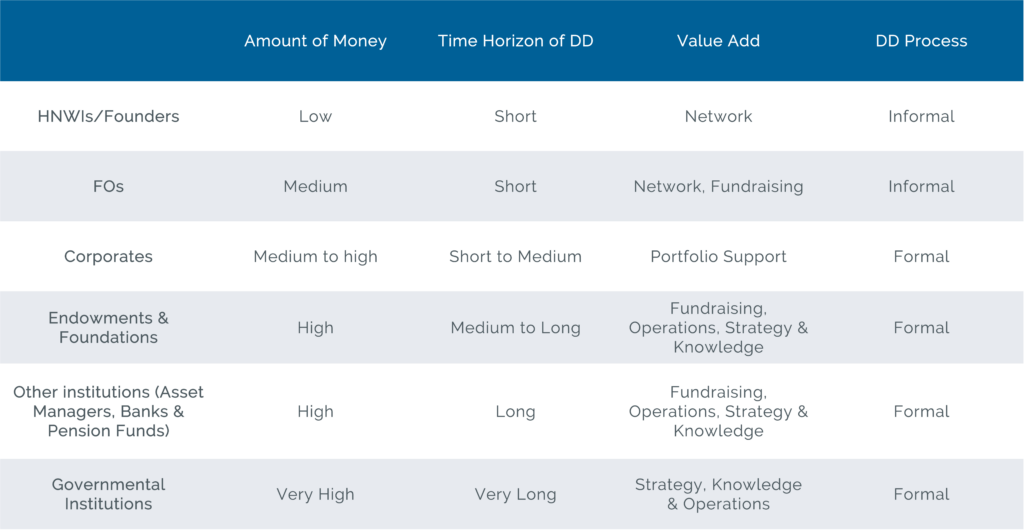For emerging managers, one of the major aspects to consider when building your firm is your LP base. The investors in your fund will impact everything from investing to operations and of course will be the major protagonists of your fundraising activities.
While founders are your customers, LPs are a critical and necessary (although not sufficient) factor in your business.
Therefore it is key to consider how to best build your LP base.
3 Factors to Differentiate LPs
When building your LP base, there are three main factors to consider: Value Add, Time Orientation and DD process.
1. Value Add
Different types of LPs can support you in very different ways:

2. Time Orientation – Short-Term vs. Patient Capital:
– Short-Term: Some investors do not have a long-term mandate or interest to be a long-term partner and to support you for many vintages. Especially in most recent periods, the industry has been flooded with LPs who are new to VC and mostly become “tourists” for a short time.
– Patient Capital: Other types of investors are more long-term oriented and committed to re-upping in the next funds. These are also the most difficult relationships to be built and the ones that require the longest periods.
3. DD process – Light vs intense:
– Light: Some LPs (e.g. founders, HNWIs) will invest without a lot of DD and in short amounts of time, focusing mostly on the personal relationships built with the GPs.
– Intense: Other LPs (e.g. endowments, public institutions) have very long and intense processes to diligence managers, but are also the most stable source of capital for the long term.
Diversifying your LP base
A critical aspect to consider when fundraising is LP diversification. Building a diversified LP base is key to sustain fundraising activities in the long run and to avoid depending too heavily on few relationships.
Diversification can be achieved across three dimensions:
1. Geography
Access to capital in different regions can be useful in different ways:
– Avoid risks related to downturns and/or political or regulatory issues
– Entry point to capture new LPs
– Know-how on different markets
– Support the portfolio in global expansion and activities
2. Diversity
More and more GPs are fortunately considering diversity in their LP base for what concerns:
– Gender
– Background
– Age
Two good examples of this are 776 and Moxxie Ventures, as described in this article from Protocol.
3. Type of LPs

1/3 Rule of Thumb
As a rule of thumb, the ideal LP composition is equally split between:
– 1/3 Founders, HNWIs and FOs
– 1/3 Strategics (e.g. Corporates, Later Stage Firms)
– 1/3 Financial investors (e.g. Funds of funds, Endowments)
Of course this is just a very high level guideline and GPs should always adapt depending on their strategies and individual contexts. For instance, vertical funds (vs generalists) with a very specific sector focus would benefit more from strategic investors.
Evolution of the LP Base across Fund Generations
GPs should think very carefully about their LP base along their firm life cycle.
Clearly, for emerging managers raising their first vintages it is quite hard to cherry pick LPs and achieve a perfect composition and diversification of their LP base.
However, as the firm matures and the brand becomes more established, GPs should make an effort to institutionalize their LP base in order to guarantee access to patient, value add capital that can support them for many years.
We at BFP recommend GPs to have an ideal target composition of their LP base from Fund I and try to achieve it more and more as the firm matures.

Considerations on Anchors
Finally, we would like to share a few thoughts on anchor investors. Finding an anchor is a key part of fundraising, as it makes easier to attract other investors.
When approaching potential anchors, managers should take into account how the relationship affects the following aspects:
Economics
Some anchors require preferential treatments such as:
– Lower fees
– Share of the carry
– Share of the GP
– Co-investment rights
– Other side letters
Decision Making
Sometimes anchors could ask for a seat in the IC. In this case, a manager should carefully evaluate such requests as the presence of an anchor should ideally not affect the normal functioning of a firm.
Allocations in Next Funds
Is the anchor requiring to have a specific allocation in the next vintages? How does this affect the potential diversification of the LP base?
We hope that emerging managers find these insights useful, as their LP base is a major component of firm building.
For any comments or feedback, feel free to reach out!
—
Authors
About Danchun Chen
Danchun joined Blue Future Partners as an Analyst in 2020 as part of the research team. She is fascinated by the great impact of venture capital and tech startups on the future economy at a global scale. Before joining BFP, she spent time in Strategy Consulting, Startups and Venture Capital across China, France, Singapore, India and Switzerland.
Danchun holds a Master in Management from EDHEC Business School in France and a Bachelor of Arts from South China Normal University.
Linkedin
About Marco Cesare Solinas
Marco is an Investment Professional at Blue Future Partners. He is passionate about Technology and Venture Capital and focuses on both direct and indirect investments. Previously, he has built an international and multicultural background across Italy, US, Germany, Turkey and Malaysia.
Marco holds a CEMS Master’s in International Management and a Bachelor´s in Economics and Finance from Bocconi University.
Linkedin — Twitter — Medium








